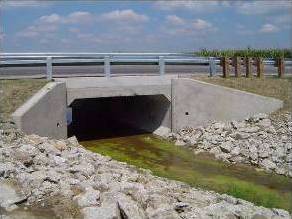Project 0-5849
Evaluating Existing Culverts for Load Capacity Allowing for Soil Structure Interaction
Abstract
This study explores culvert load rating practices and procedures as applied to TxDOT's archive of 1477 culvert designs and their inventory of more than 13,000 in-service reinforced concrete box culverts. The problem is that when older culverts are load-rated based on current AASHTO policy, many competent, serviceable culverts are shown to be deficient, requiring load posting, retrofit or replacement. A disconnect exists between culvert structural analysis practices and actual culvert performance. To address this challenge, the research focused on development of a clear, repeatable and reliable procedure for TxDOT engineers and their consultants to use for load rating culverts in the TxDOT roadway system. Articulated in TxDOT's Culvert Rating Guide, the new load rating procedure uses three increasingly-sophisticated analysis approaches, ranging from a direct stiffness frame model to a production-oriented finite element model which accounts for soil-structure interaction. Validation of the Culvert Rating Guide involved three major tasks. First, the researchers load-rated a statistically representative sample of 100 of TxDOT's culvert designs. Second, a parametric study was performed to evaluate six independent variables associated with culvert load rating. Third, instrumented load tests on three in-service culverts were conducted to compare measured demands with predicted values. This work showed that the analytical methods in the Culvert Rating Guide produce conservative load ratings yet still allow for reduction in excess over-conservatism in the load rating process.

Project PI: William D. Lawson
Project Co-PI: Priyantha W. Jayawickrama
Research Associates:
Timothy A. Wood
Rozbeh Moghaddam
Research Assistant: Suranga Gunerathne
Student Assistants:
Bolaji Afolabi
David Griggs
James Dunn
Earnest Terrell
Daniel Gerrish
Center for Multidisciplinary Research in Transportation (TechMRT)
-
Address
Texas Tech University, Box 41023, Lubbock, TX 79409-1023 -
Phone
806.742.3523 -
Email
techmrt.outreach@ttu.edu
